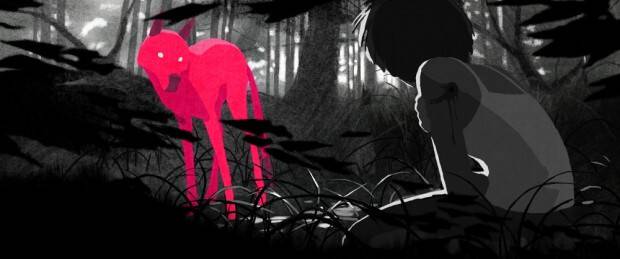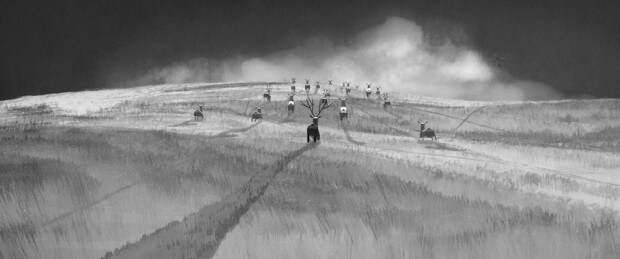Interview with BANG BANG! Director Julien Bisaro
BANG BANG! is a new short from Animator and Director Julien Bisaro. The bold film follows Éda, a retiring young woman trapped in a world where she feels obliged to follow her father’s instruction. When a car accidents reveals her alternative self, Éda must take this opportunity to decide whether to continue as normal, flee or confront her overbearing father. A combination of techniques have come together to create this highly-styled and graphic film; With a strong sense of light, camera, layout and minimal use of colour, Bisaro has created a highly emotive film that draws the audience in and connects to the shy child within us.
The project was funded by the National Centre for Cinema and the Moving Image, a French association that helps produce and aid the creation of short films. The script was co-written by Bisaro’s schoolfriend Claire Paoletti and produced by Jérôme Barthélemy and Daniel Sauvage.
Last month Julian released the film for a day online, despite its long festival run this was the first time I was able to see the film in its entirety. With a slight note of Disney’s short Paperman, Bisaro’s altogether darker tale struck me as much visually as it did narratively.
The film will be released online for good once it has finished airing on various European channels, however to tide you over Skwigly are pleased to bring you a little chat with Julien Bisaro to discuss the film in further detail.
You’ve had a range different roles within animation, including graphic designer, storyboarder as well as multiple roles as a background artist. How has this range of experience helped in the creation of Bang Bang?
My professional experiences in the different production steps of an animated film had allowed me to be quite demanding and specific in my artistic choices as a director. Thanks to this I managed to complete a relatively ambitious film in the short film economy reasonably quickly.
You co-wrote the film with Claire Paoletti, can you tell me a little about how you met and the collaboration on this project?
Claire and I met at the animation cinema school of La Poudrière in Valence, France. I intended to work with her from the very beginning of the film, but at first I took time on my own to develop the subject itself. It was important to me to deepen what I wanted to tell before starting the collaborative work. This lonely job allowed me to find the colour of the film and the narrative elements that I wanted to handle. After this brush around the subject, the characters and the film’s universe, Claire and I started what we could call “four hands writing”. We first focused on the sequences I had written and did some cleaning! My first draft was teeming with ideas but there were maybe ten films in one. We had to synthesize what I had done, make some choices, structure, see what was working, or not. At the same time I began to draw what also influenced the script. As for the writing itself, there were no rules, it could be Claire or me who wrote a sequence and we revised it all over together. We used to test the dialogue by speaking it aloud.
The story follows a young girl as she learns to break away from her controlling father, a narrative I’m sure many people around the world can relate to – what led you to telling this story?
The starting point of the film itself is a bit theoretical as it is based on the film by Alain Resnais Mon oncle d’Amérique and on the writings of Professor Henri Laborit (a neurobiologist and specialist in human behavior) about ‘inhibition in the action’. According to this scientific theory, three behaviors are possible in a conflict: to do nothing and accept the situation, to flee or to confront the situation. That is exactly the path that follows Éda, the main character of the movie! On the fringe of this psychological issue, another character creeps in the story: a pink dog! It emerged from sketches made at the Fine Arts and became sort of Éda’s wild double.
But to resume this, the main concept was: What if our inhibitions embody somebody else? A pink dog for instance… This is Éda’s and Bang Bang!‘s story.
The animation style is unique and beautiful, can you explain to us a little about how it was made?
In its graphical choices the film seeks to enhance the atmospheric side of the image, like in the nineteenth century European pictorialist photogravure: the play of shadow and light on the backgrounds, characters drawn without outlines, faces only marked with some features in order to highlight their expression.
The animation process of the film was chosen in order to have a hand-drawn rendering even though the film itself was made on computer: The characters, vehicles and vegetation, when it moves, were animated in 2D on Flash software with a graphics tablet.
The animation was drawn frame by frame (without using software interpolation) as with traditional 2D cartoon on paper. However I somehow changed the process at the end of production to save time, especially in the sequence in the father’s office at the beginning of the film, where it’s more like paper cut animation. This gives a final 3D look, I think.
Some animated backgrounds (the traveling on the road for example) are 3D, in After Effects. But the majority of the animated backgrounds are made in the 2D traditional way with different layers animated on After Effects.
How did you find yourself in the position to make your own short film, did you receive any funding or studio support?
We’re lucky in France to have the CNC (Centre National du Cinéma et de l’Image Animée) which provides funding and subsidies to finance cinema and short films based on a dossier and a careful selection.
Produced by Caïmans Productions and partly animated and composited in the Parisian and friendly studio Je Suis Bien Content, Bang Bang! was supported by the CNC, the Lagardère Foundation (I won the Young Animation Talent prize for the film), the City of Paris and the Abbaye de Fontevraud where I spent one month with Claire in an artistic residency. The film is also co-produced by the french channel Arte.
The film has already been to many festivals, how have you found the reaction to the film around the world?
Through some metaphorical aspects, such as the enigmatic pink dog wandering around in the woods, the film leaves the viewer a degree of interpretation of their own. It’s always very interesting for me to hear how this story resonates and is interpreted by each viewer according to their own personal history and culture. I have had some particularly interesting reactions in China and Japan, where the film is very well-received. In a way, the film lives it’-s own life now!
 As far as your plan for the film goes, having released it for a day online in February will you be releasing it online for good after its festival run or do you have another distribution route planned?
As far as your plan for the film goes, having released it for a day online in February will you be releasing it online for good after its festival run or do you have another distribution route planned?
The film was available on line for a short period of time in February because it was nominated for the César (French cinema award). After that, we had to close the public access to the Vimeo link because Arte channel holds the broadcasting rights for a period that is still underway. The film is also broadcast on TV5 Monde and Canal + Spain. My producers will put the film online for good when the film rights expire. So remain patient!
See more of Julien’s work at julienbisaro.com


